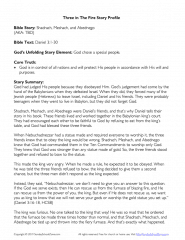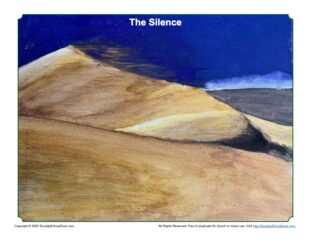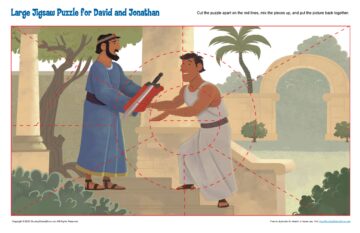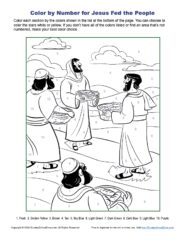Three In The Fire Story Profile
The story of Shadrach, Meshach, and Abednego in the fiery furnace is as familiar to many as it is dramatic. This Three In the Fire Story Profile provides a simple overview/summary of the story (for kids) along with commentary (for parents and leaders), points of interest, and an approximate date for the story. A printable PDF for this profile is available here and all related activities are listed here.
Bible Story: Three In the Fire
AKA: Shadrach, Meshach, and Abednego
Bible Text: Daniel 3:1-30
God’s Unfolding Story Element: God chose a special people.
Core Truth:
- God is in control of all nations and will protect His people in accordance with His will and purposes.
Story Summary:
God had judged His people because they disobeyed Him. God’s judgement had come by the hand of the Babylonians when they defeated Israel. When they did, they forced many of the Jewish people (Hebrews) to leave Israel, including Daniel and his friends. They were probably teenagers when they went to live in Babylon, but they did not forget God.
Shadrach, Meshach, and Abednego were Daniel’s friends, and that’s why Daniel tells their story in his book. These friends lived and worked together in the Babylonian king’s court. They had encouraged each other to be faithful to God by refusing to eat from the king’s table, and God had blessed these three friends.
When Nebuchadnezzar had a statue made and required everyone to worship it, the three friends knew that to obey the king would be wrong. Shadrach, Meshach, and Abednego knew that God had commanded them in the Ten Commandments to worship only God. They knew that God was stronger than any statue made of gold. So, the three friends stood together and refused to bow to the statue.
This made the king very angry. When he made a rule, he expected it to be obeyed. When he was told the three friends refused to bow, the king decided to give them a second chance, but the three men didn’t respond as the king expected.
Instead, they said, “Nebuchadnezzar, we don’t need to give you an answer to this question. If the God we serve exists, then He can rescue us from the furnace of blazing fire, and He can rescue us from the power of you, the king. But even if He does not rescue us, we want you as king to know that we will not serve your gods or worship the gold statue you set up.” (Daniel 3:16-18, HCSB)
The king was furious. No one talked to the king that way! He was so mad that he ordered that the furnace be made three times hotter than normal, and that Shadrach, Meschach, and Abednego be tied up and thrown into the fiery furnace. And that’s exactly what happened.
But the three men didn’t die! And as the surprised king looked into the furnace, he couldn’t believe his eyes. “Didn’t we throw three men into the fire,” the king asked. “Yes, of course, Your Majesty,” he was told. He exclaimed, ‘Look! I see four men, not tied, walking around in the fire unharmed; and the fourth looks like a son of the gods.’
The surprised king called the men to come out of the fire, and they did. The three men were untouched by the flames. . . and that probably made the king afraid. He had made a statue and commanded everyone to worship it, because the king thought he was stronger than God. When he commanded the three friends to be thrown into the fire, the king didn’t believe in their God, but when they came out of the fire unhurt, the king was convinced that God was powerful. So, the king made a new rule that everyone should worship the God of Shadrach, Meshach, and Abednego.
But what about the fourth person in the furnace? Honestly, we don’t know. What we do know is that God promises to be with His people whatever we face, and He showed us the extent of His love when Jesus paid the price for our sin by dying on the cross and rising from the dead. Today, we know more than the three friends did as they faced the angry king, but their story reminds us that God is in control of all nations and will protect His people in accordance with His will and purposes.
Commentary:
This simple story affirms some important and foundational biblical truths. As with most texts, however, we should not jump too quickly to the “truths” without first considering the context of the story.
Following King Solomon’s prosperous rule, the Kingdom of Israel experienced a civil war and divided into two kingdoms… Israel in the north and Judah in the south. Both nations followed an idolatrous path, however, and in 722 BC, Israel fell to the Assyrians. The people of the Northern Kingdom were dispersed and the nation of Israel essentially disappeared from history. Judah managed to survive for more than a hundred years until the Babylonians invaded the Southern Kingdom and began deporting some of the people prior to 600 BC. In 587 BC, the Babylonians, under King Nebuchadnezzar, finally destroyed Jerusalem and the temple and completed the deportations. The people were now firmly in the midst of the Babylonian Exile.
Daniel, the author of this book and story, was among those deported to Babylon in 605 BC, prior to Jerusalem’s destruction roughly 18 years later. We don’t know just how old Daniel was when he was taken to Babylon, but he lived to see the fall of Babylon to Persia in 539 BC and a number of events following. Thus, Daniel lived through the entire core of the Babylonian Exile and probably lived to be approximately 80 years old.
This historical context is important because it helps us understand what Daniel is trying to accomplish in the book and in this story. As with the book as a whole, this story teaches the sovereignty of God (Yahweh, the God of the Bible) over all nations. His sovereignty is affirmed even though Yahweh’s people (Judah) had been clearly defeated by the Babylonians (who did not acknowledge Him) and were now living as exiles in a foreign land.
The common belief among most people (non-Jews) of that day was that there were many gods. These gods were often associated with local people or lands and were, therefore, somewhat limited in their powers. If one nation conquered another nation, that demonstrated that the god of the conquerors was stronger than the god of the conquered. The Babylonians assumed that because they had defeated Judah in battle, their god(s) were superior to the God of Judah (the Jewish people). Many of the Jews, now living in Babylon, would have been tempted to believe this themselves.
The core message of Daniel is that the God of the Hebrews (Yahweh) is still Lord over all nations, including Babylon, even though Babylon had defeated them in battle. In fact, it was Yahweh who had given Nebuchadnezzar the power to conquer Judah as an instrument of God’s judgment on them because of their persistent sin and rebellion against Him. The people would experience exile in Babylon as punishment for their sin, but Yahweh nonetheless remained the sovereign Lord over all people and nations, including Babylon.
The story of Shadrach, Meshach, and Abednego in the fiery furnace begins with Nebuchadnezzar assembling his government officials, including these three young Hebrews, on the “plain of Dura” in order to affirm their loyalty to him by bowing before and worshiping a large “gold statue.” We are not told what the statue represented, but it probably was a statue of Babylon’s primary god.
It should be noted that chapter 2 ends with Nebuchadnezzar paying “homage to Daniel” and declaring that “Your God is indeed God of gods…” Apparently his recognition of Yahweh as “God of gods” was somewhat superficial. Rather than perceiving Nebuchadnezzar simply as fickle, this is more likely a reflection of the common belief that there were many gods and it was not unusual to worship more than one. Nebuchadnezzar’s insistence that his officials “fall down and worship the gold statue” was likely driven more by his political need to control these officials than by strong religious convictions. Whatever he might have professed about the gods, Nebuchadnezzar’s primary devotion was to himself. He needed his governmental leaders to be loyal to him.
When Shadrach, Meshach, and Abednego refused to worship the statue, the king confronts them and offers them another chance to bow before the statue. Their courageous response reveals their deep convictions that God is able to save them, even if He chooses not to…
Nebuchadnezzar, we don’t need to give you an answer to this question. If the God we serve exists, then He can rescue us from the furnace of blazing fire, and He can rescue us from the power of you, the king. But even if He does not rescue us, we want you as king to know that we will not serve your gods or worship the gold statue you set up.
This amazing statement is consistent with Old Testament theology. God (Yahweh) is the sovereign Lord of all nations and the entire world. His will and purposes may not always be known to His people, but He is always in control. He is driven by His purposes, not by people or the powers of puny kings.
When Nebuchadnezzar heard their reply, he became enraged and had them throne into the fire. He then sees them walking around in the fire with a fourth person that he describes as a “son of the gods.” We should not read too much into this phrase as it comes from the lips of a pagan king. He was not a biblical theologian. Nonetheless, something about the “fourth” man appeared to be divine and, therefore, a representation of divinity. Nebuchadnezzar understands the fourth man to be God or God’s representative, an angel. He calls for the three Hebrew men to come out.
The three young men come out of the furnace and have been miraculously saved from any impact of the fire. Nebuchadnezzar recognizes the miracle as an act of their God and, in addition to praising Yahweh, issues a decree that no one is to say anything offensive about Him.
The story is simple and straightforward. The nations of the world may claim other gods and give them devotion. They may, at times, even be able to defeat God’s people in military battle. But Yahweh remains in control of all nations and will protect His people in accordance with His will and purposes.
Points of Interest:
- Some have questioned why Daniel is absent from this story. Was he there and did he bow before the statue? Certainly not. The real answer comes in the last verse of the prior chapter. Daniel has been promoted (in response to interpreting the king’s dream) and Shadrach, Meshach, and Abednego have been appointed “to manage the province of Babylon.” We are then told that for some reason… “Daniel remained at the king’s court.” Daniel is not mentioned in the story because he simply wasn’t there.
- Daniel lived to see the fall of Babylon to the Persians in 539 BC. It was not long after this that we read about Daniel in the lion’s den in Daniel chapter 6. We should be careful, therefore, not to confuse the king in this story (Nebuchadnezzar) with the ruler in the story of Daniel in the lion’s den (Darius).
- It was soon after Persia conquered Babylon that the Jews were told they could return to Judah if they wished to do so. Many did return, but not all. During the years of exile, many of the exiled Jews had established homes, had become leaders in the land (like Daniel), and had become comfortable there. Nonetheless, the fact that they were free to return signaled that the Babylonian exile was beginning to come to an end.
Approximate Date:
It is most likely that this event occurred somewhat early in Nebuchadnezzar’s reign, but not before 603 or 602 BC, as this is when Daniel interpreted the king’s dream. The event probably occurred relatively soon after that as the note at the end of chapter 2 regarding Daniel’s remaining at the king’s court seems to explain why he is not mentioned in the story of Shadrach, Meshach, and Abednego.
- Related Activity Links:
- Divine Power ,
- Shadrach, Meshach, and Abednego ,
- Grade School (Readers), Preschool (Non-readers) ,
- Three In The Fire




